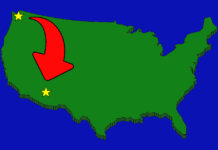
After the bombing of Pearl Harbor and America’s entry into World War II, residents of Maricopa adjusted to the changes.
Oliver and Ava Sloan had begun farming land east of Maricopa in 1938. When America entered the war a demand for agricultural products brought stable income from the sale of their crops – alfalfa, wheat and cattle. Arizona, in general, benefitted financially from the war.
Rural life was good, and food was abundant.
“We butchered our own beef,” said Ava. “Canned it in fruit jars in a pressure cooker.”
“I baked our own bread, and we had a good garden. We ate better than we do now,” she said in 1988. “I churned our own butter, made cottage cheese and had all the milk and cream we could use.”
On Sundays area kids collected at the Sloan farm to rope, ride and play. For the most part, the Sloan kids were content to stay in the area, except on Saturdays when the family would drive to Chandler or Casa Grande to see a show.
“We gave the kids a quarter. They got in the show and ate popcorn on that,” Sloan said.
“We bought $5 of groceries that would last for a week. Then we sat in the car to watch the people passing on the sidewalk. We visited with those that were doing the same.”
“We made ice cream. Got ice off the cars that were on the railroad track.”
One day, Harry Hall, a cook who worked for the railroad, gave Ava 100 pounds of sugar. “That was during the war when sugar and shoes were rationed,” she said. It was a real treat for the family.
Ava says during that time they had a dog named Chow. “He would ‘hitchhike’ a ride to Maricopa,” said Sloan. “He would go sit down by the gate at the road and wait until Rex Anderson came by.”
Anderson would stop, and the dog would jump into the car. Later in the day, Anderson would stop at the Sloan’s gate, and the dog would jump out and go to the house.
“We had an old Billy Goat, too,” she said. “He and Chow would trot the road to Maricopa.”
“Someone would take them in the restaurant, feed Chow and give the old goat either beer or whiskey. The goat got to liking it. He would get drunk, then come home and crawl under the house and sleep it off.”
The war years weren’t all fun, frivolity and prosperity for Maricopa.
In 1942, the Federal government began rounding up Americans of Japanese descent and placing them in internment camps. (For more information, click here)
One of the facilities was located just a few miles from Maricopa on the Gila River Indian Community. Divided into two camps, the Gila River War Relocation Center held 13,348 detainees at its peak population – Arizona’s fourth largest community at the time.
Although the camps were well organized and grew much of their own produce, local cattle growers often supplied beef.
The Sloans were one of those resources. Ava remembered rounding up the cattle and selling them to the government.
One day, while rounding up the cattle, she noticed something curious. “We’d drive them over (to the camp),” she said. “In a few days this old cow would be back.” She figured the cow must have been driven to the camp three or four times and somehow made its way back to the farm each time.
In 1945 the camps closed. By that time Maricopa had established itself as a dependable resource for agricultural products, and more farmers began moving into the area.

![‘Flying Bucket Fire’ doubles size, causes $200K in damage Tucson's Northwest Fire District crew members assist in firefighting efforts on the "Flying Bucket Fire" approximately 15 miles southwest of Maricopa on May 8, 2024. [Northwest Fire District]](https://www.inmaricopa.com/wp-content/uploads/2024/05/northwest-fire-district-050824-flying-bucket-fire-01-218x150.jpg)
![GAME OVER: The city government tried to get into gaming. It failed Maricopa Esports [Victor Moreno]](https://www.inmaricopa.com/wp-content/uploads/2024/05/263342f5-13e7-4668-838c-f574392086fb-218x150.jpg)



![Rizz party organizers say city ‘lying’ One of several flyers for a "TikTok rizz party" is taped to a door in the Maricopa Business Center along Honeycutt Road on April 23, 2024. [Monica D. Spencer]](https://www.inmaricopa.com/wp-content/uploads/2024/04/spencer-042324-tiktok-rizz-party-flyer-web-218x150.jpg)
![Province writer opens the athlete’s mind in new book Tom Schuman, a Province resident, poses with a copy of his new book, "My Wide World of Sports," outside his home on May 2, 2024. [Monica D. Spencer]](https://www.inmaricopa.com/wp-content/uploads/2024/05/spencer-050224-tom-schuman-sports-book-web-01-218x150.jpg)







![JWP to see more restrictions Monday John Wayne Parkway [Brian Petersheim Jr.]](https://www.inmaricopa.com/wp-content/uploads/2023/03/991A6929-100x70.jpg)

![Traffic change to reduce backup at Villages intersection The intersection at Butterfield Parkway and West Edison Road on May 10, 2024. [Brian Petersheim Jr.]](https://www.inmaricopa.com/wp-content/uploads/2024/05/PJ_5644-100x70.jpg)